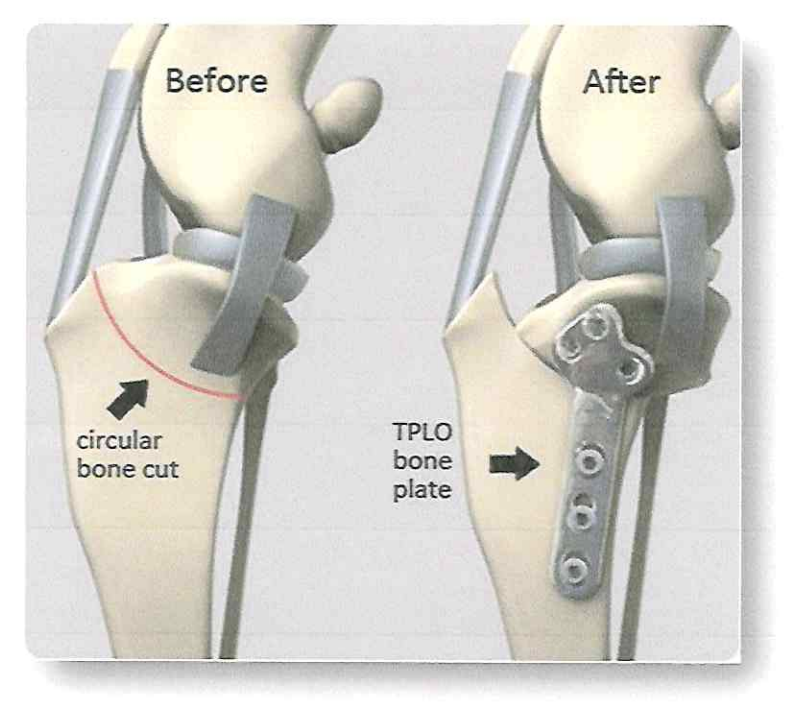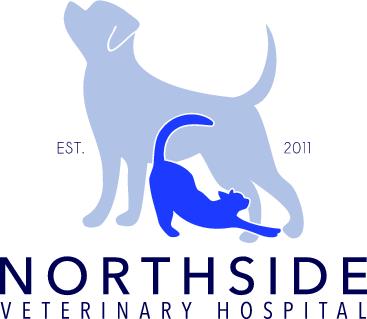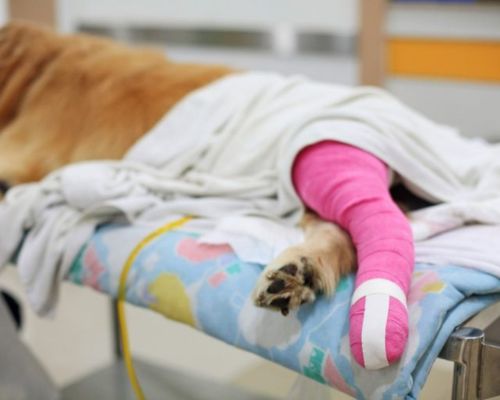Pet TPLO
The TPLO (Tibial Plateau Leveling Osteotomy) procedure neutralizes the effect of this drawer motion. A circular cut is made at the top of the tibia, and the smaller portion of the bone is rotated to reduce the slope of the tibia.
Pet TPLO in Shawnee, OK
A special surgical-grade stainless steel plate is used to hold the two bone segments together. Over time the bone segments will heal together to provide lifelong stability.
Cranial Cruciate Ligament (CCL)
There are a number of ligaments in a dog’s stifle (knee) that contribute to joint stability. The Cranial Cruciate Ligament (CCL) is the primary ligament responsible for limiting “cranial drawer” motion (excessive forward and backward sliding of the femur on the tibia bone). When a dog has a partial tear or ruptures this ligament, the joint instability causes inflammation and pain, which is why your dog favors the leg. Osteoarthritis, also known as OA, degenerative joint disease, or degenerative arthritis, is a form of arthritis caused by inflammation, breakdown, and the eventual loss of joint cartilage. There are many factors that lead to the progression of osteoarthritis; failure to stabilize this joint will accelerate this process.
Common Questions and Answers regarding orthopedic surgery:
Q: Does my dog really need surgery? I read that they’ll do just fine without surgery.
A: Published data suggest that approximately 15% of dogs will recover reasonably good clinical function without surgery. Most of those dogs will be small breeds, under 15-20 pounds of body weight. Those that recover normal function tend to do so within 4-6 weeks after they first become lame. For the majority of dogs, surgery is the only way to return them to good function, period….not braces or medications or herbs or rehabilitation or wishing or hoping!
Q: Which patients will benefit from TPLO?
A: While the procedure can be performed on just about any patient, including small dogs and cats, PLO seems to be most applicable to larger breed, active dogs. Although some surgeons have differing opinions, most feel that smaller dogs will do equally well regardless of what procedure is performed. In general, dogs weighing over 45 pounds (20 kg), especially if they are very active, will benefit the most from TPLO.

Q: Why is PLO so costly, especially when compared to other cruciate repair surgeries?
A: PLO requires specialized equipment, including a motorized bone saw with a specially-designed curved blade, a surgical stainless steel bone plate, and 6-9 bone screws, between 4-6 X-rays, a significant investment in training on the part of the surgeon, and up to 2-4 hours of preparation, surgical and recovery time for each patient.
Q: What about possible complications?
A: PLO is major surgery, and complications are possible. Published reports suggest the short-term complication rates may be somewhat higher than with less invasive surgeries. Still, long-term complications and failures are shown to be higher in less invasive procedures. Other factors that are involved in short-term complications include individual patient abnormalities and surgeon experience with the procedure. Most complications are minor in nature in that they can be resolved without additional surgery and have an ultimately successful outcome. Included in this category would be things like infections and inflammation of the patellar tendon. More major complications, including failure of plates or screws and fracture of the tibia or fibula, are uncommon. The development of bone cancer many months or years later in the area of the surgery has been noted in a small number of TPLO dogs. The possible connection of this cancer with the procedure is highly controversial as the top portion of the tibia is a common location for bone cancer in the dog, even when no surgery or cruciate problem is a factor. Also, note that in the beginning phases of bone cancer (when it is unable to be detected by radiographs), inflammation and pathological changes can affect the strength of the tendons, making them weaker and more vulnerable to rupture. Whether the rate of such cancers in TPLO dogs is higher than normal is not clear. One of the most common postoperative complications is not directly related to the IPLO procedure. Tears of the meniscal cartilage in the stifle are a common consequence of an unstable joint. Such tears may exist at the time of surgery and can develop in up to 11% of patients after surgery. That’s true in dogs and humans, regardless of what kind of surgery they undergo. Typically, these patients do well for weeks or months after surgery before suddenly becoming lame again.
Q: What aftercare is required?
A: Recovery time usually runs from 8 to 12 weeks with strict confinement. Pets will need to be housed in small confined areas like a kennel 24hrs a day. Leash walking for potty break ONLY and back into a confined area. Following bone healing, there is a gradual return to function with rehabilitation. Well over 95% of our cases have improved to the point of showing no lameness after a few months—follow-up X-rays at various stages to gauge the healing of the cut in the bone. Once bone healing is complete, then exercise can be increased to normal.
Q: Is TPLO really better than other surgical options?
A: There are many factors that contribute to the cause of your dog’s cruciate rupture, such as the anatomic angle of the knee, weight, traumatic injury, age, and underlying endocrine diseases. The PLO has produced far better results across the board in all patients. Still, all of the contributing factors will be taken into consideration, and each individual case will be evaluated to see if the TPLO is right for your pet. For a good part of the first 20-25 years after the development of TPLO, surgeons were faced with a paradox: they were seeing significantly better results with TPLO than with other procedures they had used in large dogs. In the last few years, the research data has been starting to confirm what surgeons have known all along: TPLO dogs return to function faster, they develop less joint arthritis, and they tend to return to better functional levels than is seen with other techniques. Some techniques worked better than others, but all had their drawbacks.

